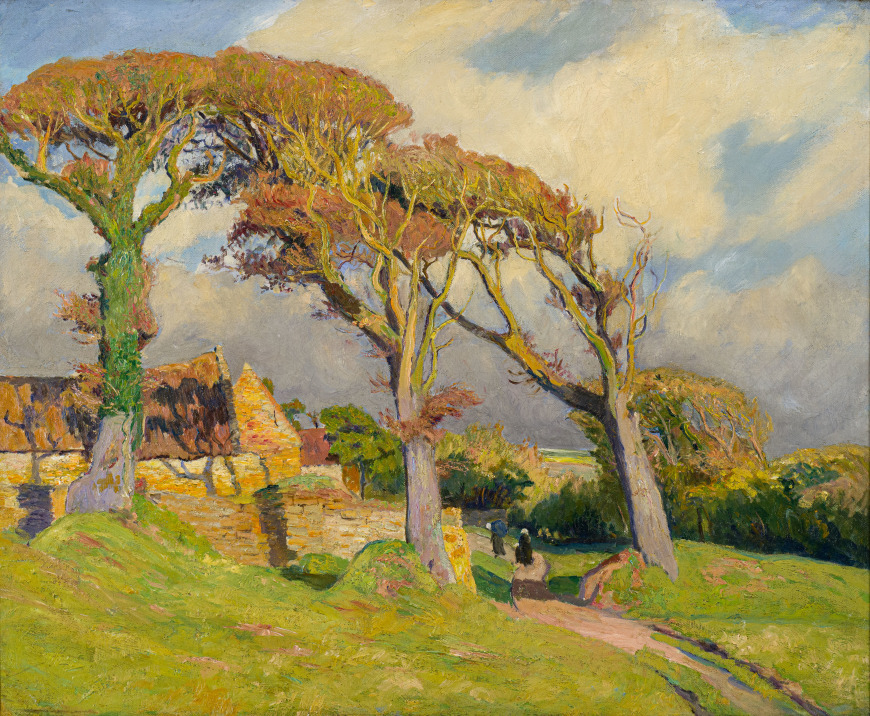60.3 x 73 cm
Alan Klinkhoff Gallery Cullen Inventory No. AK190.
Walter Klinkhoff Gallery Cullen Inventory No. 190
Inscriptions
inscribed, ‘No 7’ (verso, stretcher)Provenance
Agnes Pilot, sister of Robert Pilot and step daughter of the artist
By descent, grand-daughter of Agnes Pilot, Virginia, U.S.
Heffel Fine Art Auction House, Fine Canadian Art, 24 November 2006, lot 37
Galerie Walter Klinkhoff Inc., Montreal
Property of a Distinguished Montreal CollectorDocumentation
Power Financial Corporation, Annual Report 2006 (Montreal: Power Financial Corporation, 2007), 25 [reproduced].With The Three Sisters, Maurice Cullen offers a portrait of statuesque trees in autumn, their trunks slightly inclined toward each other and their uppermost branches entangled. Together they soar above buildings and a forest beyond; two miniscule figures on the road that curves through the composition underscore the trees’ gigantic heights. A solid balance of colours creates harmony in the scene: the rust tones of the foliage are echoed in the brick walls and rooves of the buildings; lime and olive shades in the field in the foreground are carried through to the forest. Dark grey clouds along the horizon give the impression of rain having just blown through, and their presence, as well as the sharp shadows of the trees, suggest that the sunlight is strong and warm at this moment.
The painting depicts a site in Brittany (a variation of this scene was exhibited as Brittany Landscape at the Canadian Art Club in 1910), a region Cullen first visited as a young man. When he was twenty-one, he moved to Paris to study art, and he lived in Europe for seven years, studying at the École des Beaux-Arts, the Académie Colarossi, and the Académie Julian. Brittany was highly popular with artists in France in the late 1800s and early 1900s: it was accessible by railway; it was inexpensive to stay there; and it was known for interesting landscapes and traditional rural culture. In 1894, American artist Lovell Birge Harrison (1854–1929) wrote that “Rough moorland and solemn pines predominate, but there are not lacking delicate beech woods, purling streams and soft idyllic pasture lands”—there was a wide range of possibilities for the landscape painter.[1]
Many international art students visited Brittany, including several who were enrolled in the atelier of Jean-Léon Gérôme (1824–1904) at the École des Beaux-Arts. [2] When Cullen began studying in Paris, Gérôme was his first teacher, and it may have been at Gérôme’s encouragement that he first went to Brittany (though famous for his academic paintings, Gérôme is known to have offered students advice about sketching trips). [3] As well, Canadian artists, including Paul Peel (1860–1892), William Edwin Atkinson (1862–1926), and Farquhar McGillivray Knowles (1859–1932), had begun painting in Brittany by the early 1890s. Cullen is believed to have made several trips to the area between 1888 and 1895, and he later returned in 1900–1. [4] He painted in Pont-Aven and Le Pouldu, and his Breton landscapes include The Tidal Mill, Brittany, 1900, Winter in Brittany, c. 1900 (both Art Gallery of Hamilton) and Brittany Farm, c. 1900–2 (Vancouver Art Gallery).
Although Cullen’s French landscapes constitute a small part of his oeuvre, they mark a critical aspect of his artistic development because while he was studying in France, Cullen was surrounded by artists who were experimenting with painting en plein air. The practice of working outdoors had been critical to modern French landscapes since the mid 1800s, firstly for the leaders of the Barbizon School and then for the Impressionists. Cullen’s early sketching trips in rural France were the beginning of a lifelong commitment to painting outdoors—after he returned to Canada, he worked outside year-round, most famously in the creation of his iconic winter landscapes.
Jocelyn Anderson
______________________
Footnotes:
[1] Birge L. Harrison, “Quaint Artist Haunts in Brittany,” Outing: An Illustrated Monthly Magazine 24, no. 1 (1894): 28.
[2] David Sellin, Americans in Brittany and Normandy, 1860–1910 (Phoenix: Phoenix Art Museum, 1982), 2.
[3] H. Barbara Weinberg, The American Pupils of Jean-Léon Gérôme (Fort Worth, Texas: Amon Carter Museum, 1984), 8.
[4] Sylvia Antoniou, Maurice Cullen, 1866–1934 (Kingston: Agnes Etherington Art Centre, 1982), 6.












